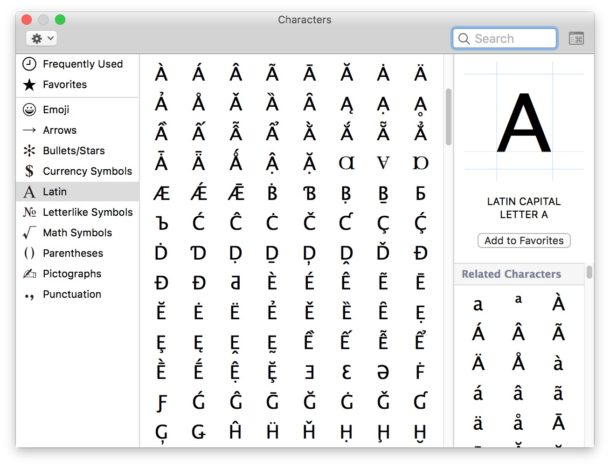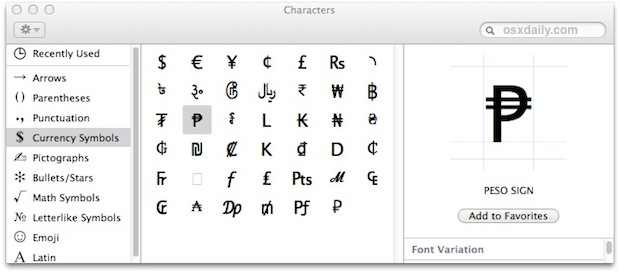Access Mac Special Characters with the Character Viewer

Special characters can be accessed easily in Mac OS X through a special floating window called the “Character Viewer”. From within this characters menu, you’ll find a list of various dingbats, arrows, parenthesis, foreign currency symbols, pictographs, bullets and stars, math symbols, letterlike symbols, Emoji, and latin characters, plus a helpful “Recently Used” option which gathers a list of the most frequently accessed special symbols.
This quick tutorial will show you how to access all special characters available to a Mac by using the special Symbol and Character Viewer tool.
How to Access All Special Characters in Mac OS X
To access this Character Viewer in nearly any Mac OS X application, you just need to do the following:
- Place the cursor somewhere you can enter text
- Pull down the “Edit” menu, then choose “Emoji & Symbols” or “Special Characters” (the labeling differs in Mac OS versions)
Now you can locate and click on the special character to type it or enter it into the text entry point. You can also copy the special characters to the Mac clipboard by using the copy and paste Mac keystrokes.
If you don’t find the option available, click the cursor into a text field or text entry box, which then typically makes it accessible. Almost any app that supports typing will allow you to gain access to this Characters menu.

Alternatively, most Mac apps support a simple keystroke to summon the panel as well, which is Command+Option+T
Newer versions of Mac OS X support typing many Emoji characters this way, which can be found under the Emoji submenu of the panel.
From this special character viewer, you can easily insert any special character and browse through all of the special characters available to Mac OS X. You can also use it to insert special characters in foreign languages, assuming you have the foreign language packs installed. You will find older versions of Mac OS X had more characters available by default, and newer versions of Mac OS X will require those language backs to be installed before the characters can be accessed. The screenshot below demonstrates this, with Greek symbols, latin accents, braille patterns, and digits available:

To get those on newer Macs, you will need to install those keyboard or language packs through the “Keyboards” control panel.
All in all, using the character viewer is obviously a lot easier to use than trying to memorize some of the more obscure key commands for typing accented letters and the Apple logo , so if you find yourself stumped on memorizing those keystrokes, just open the characters menu instead.


This feature has changed a little since this article was published. To open the symbols panel, it works by pressing ctrl-cmd-space. However, the smallish panel that opens is somewhat different from the window that appears in the article.
The small panel that opens is, by default, a panel strictly for emojis and limited other special characters. To see to all of the characters available, you’ll need to click the icon in the upper right corner of the window to expand the available selections. Clicking this icon will convert the panel into a window with more selections, including Latin.
However, if you’ve scrolled down into this emoji panel looking for a character, that icon might have disappeared. The panel remembers where you’d scrolled last. To reveal this icon, you’ll need to scroll all the way to the top revealing the search panel. This icon only appears to the right of the search panel when the visible. Otherwise, this icon is hidden.
How can you search the character view for a hard (non-breaking) space (U+00A0)?
Typing ‘space’ into the search box doesn’t work – it’s interpreted as ‘s, p, a, c, e’.
Typing ‘ ‘ into the search box doesn’t do much either. That seems to be interpreted as a null entry.
I tried the pound symbol with the character viewer but in Twitter they do not accept it in my password.
These instructions are for older versions of iMac.
For El Capitan use:
Pull down menu EDIT, EMOJI&SYMBOLS
You can see next to EMOJI&SYMBOLS that the keystroke command to pull up the window is Control+Command+Space or ^⌘Space.
Once the window is open do 2 things.
Click the upper right little box to make more columns show up.
Then click the upper left gear and choose customize list to get more types to show up.
For example, to get the ⌘ symbol you have to turn on the “Technical Symbols”.
I hope that helps update this for everyone.
Thank you! I wasted so much time online trying to find a way to get a simple macron over a letter. I wish I had seen this first.
Emoji and Symbols does not work for me at all OSX 10.11.3
Really annoying.
Doesn’t work for me. The special character viewing panel list drops down but when I click on it, doesn’t open anywhere. Am baffled. Its not as if the pound sterling is a rare mongolian currency.
Its a great big oversight NOT including it in the available top monetary symbols. When I do the options+3+T or whatever your erroneous instructions are I just get #. And since I’m not a twitterer I don’t want it.
Please be more coherent next design round.
If you don’t follow the instructions properly then you won’t be able to access the special character panel, not surprising. All of the monetary symbols of the world are included in special characters, follow the instructions exactly.
[…] symbols for currencies can be accessed through the Character viewing panel, which can be summoned just about anywhere that you can type on the Mac by pulling down the […]
Same as Stacy. Did nothing but hide the uppermost row of my ribbon.
It didn’t work for me. I tried Command-Option-T and all it did was hide my ribbon. :-(
Thank you so much I really Love your website
☑★★★★★★★★★★★★★★★★★★★★★★★★★★★
Thanks!⌘